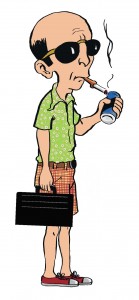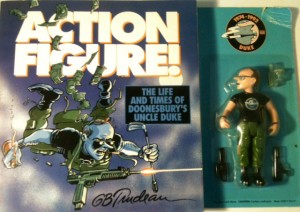
My version of Hunter S. Thompson, which I pencilled while recently watching Fear and Loathing in Las Vegas
When the going gets weird, the weird turn pro. Hunter S. Thompson understood this universal truth and took it as his mantra for flying the freak power flag higher than anyone around. In doing so, he developed a caustic, take-no-prisoners style of writing ultimately known and revered as Gonzo Journalism. No matter what aspect of modern living Hunter covered in his lengthy career as a Doctor of Journalism, he never failed to expose the naked, awful truth. Even if he had to make it up.
That, above all else, was Hunter’s charm. You just never knew whether he was telling the whole truth, wrapping the truth in some form of allegory, or shining you on with something so outrageous that the true, mind-blowing reality of what he really had to say wouldn’t seem so odd.
Hunter lived hard and fast. Drugs and alcohol were as much tools to him as were his tape recorder, typewriter and mojo wire. As much as possible, in true gonzo fashion, Hunter would insert himself into the story. He started by riding with the Hell’s Angels in the mid-sixties when he was gathering material to write his exposé of them. It worked so well, he never looked back and worked that trick to such success that he even managed to get to ride along in a limo with Nixon to talk football during coverage of the presidential election. Hunter’s year-long odyssey within the American political machine found its way regularly into Rolling Stone magazine before being packaged in book form as Fear and Loathing: On the Campaign Trail ’72.
Hunter’s most famous piece of writing is Fear and Loathing in Las Vegas. It was adapted for film by Terry Gilliam and starred Johnny Depp in the role of HST/Raoul Duke. Depp’s portrayal is regarded as the most true to form, usually favoured over Bill Murray’s turn as Hunter in the bio-pic Where the Buffalo Roam. I find both films have their strengths. Fear and Loathing sticks strictly to the source material, whereas Buffalo gives us more of a glimpse of the circus which Hunter’s life became as he was increasingly hamstrung by the public’s expectations of him as a gonzo writer.
Hunter chafed at the legend which had grown around him. He often expressed how, as the legend grew to have a life of its own, he himself had become largely unnecessary. Perhaps in some respect this was true. Certainly he was aware that too many aspects of his life/legend were beyond his control. The gonzo style, which had at one time brought him recognition and success, inevitably became a drawback. It had the effect of creating a larger than life persona which turned into a caricature. Worst of all, the caricature was what people clamoured for Hunter to be. There was no escaping his fate.
Hunter’s role as a cartoonish counter-culture icon was cemented by his portrayal in Garry Trudeau’s Doonesbury comic strip. Like Hunter, Trudeau took aim at modern American life often satirizing many of the same targets. Trudeau’s character Uncle Duke may not have impressed Hunter, but readers the world over responded and the good doctor returned as a constantly recurring character over the years. My personal favourite storyline was when Duke gets hired as the manager for the Washington Redskins. Player doping, gambling, greed and corruption ensues to hilarious effect. Eventually Trudeau had enough material for a collected version of Uncle Duke’s adventures to be published. Action Figure came with it’s own vinyl figure complete with such accessories as a martini glass and a sub-machine gun.
 Of course, the caricature studies of Hunter all started much earlier than Doonesbury. Hunter was paired with British illustrator Ralph Steadman whose own frenetic pen and ink style easily matched Hunter’s vitriolic prose, capturing the hyper-kinetic energy so prevalent in Hunter’s best writing. They met on assignment for Scanlan’s Monthly producing an article called “The Kentucky Derby is Decadent and Depraved”. The pair became friends and Steadman came to illustrate many of Hunter’s antics over the years (including Fear & Loathing in Las Vegas), with one final collaboration on a book/adventure: The Curse of Lono.
Of course, the caricature studies of Hunter all started much earlier than Doonesbury. Hunter was paired with British illustrator Ralph Steadman whose own frenetic pen and ink style easily matched Hunter’s vitriolic prose, capturing the hyper-kinetic energy so prevalent in Hunter’s best writing. They met on assignment for Scanlan’s Monthly producing an article called “The Kentucky Derby is Decadent and Depraved”. The pair became friends and Steadman came to illustrate many of Hunter’s antics over the years (including Fear & Loathing in Las Vegas), with one final collaboration on a book/adventure: The Curse of Lono.
Eventually Hunter wrote his own ending, committing suicide on February 20, 2005. He left a suicide note titled “Football Season is Over” and, true to gonzo form, had his ashes shot out of a canon at his funeral.




